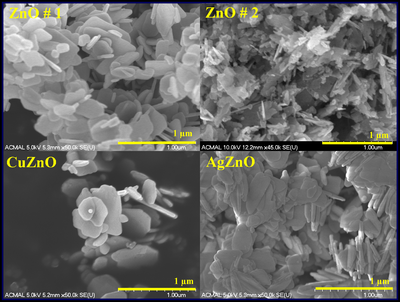J.M.Pearce (talk | contribs) mNo edit summary |
J.M.Pearce (talk | contribs) m (→Abstract) |
||
| (2 intermediate revisions by the same user not shown) | |||
| Line 5: | Line 5: | ||
==Source== | ==Source== | ||
* A. Chandrasekaran, J. Mayandi, J. Osborne, M. Frost, C. Ekstrum, J. M. Pearce. Inhibition of growth of S. epidermidis by hydrothermally synthesized ZnO nanoplates” Materials Research Express 4(7) 075401. https://doi.org/10.1088/2053-1591/aa796d [ open access] | * A. Chandrasekaran, J. Mayandi, J. Osborne, M. Frost, C. Ekstrum, J. M. Pearce. Inhibition of growth of S. epidermidis by hydrothermally synthesized ZnO nanoplates” Materials Research Express 4(7) 075401. https://doi.org/10.1088/2053-1591/aa796d [https://www.academia.edu/33887255/Inhibition_of_growth_of_S._epidermidis_by_hydrothermally_synthesized_ZnO_nanoplates open access] | ||
==Abstract== | ==Abstract== | ||
The antibacterial effect of zinc oxide (ZnO#1) as prepared and annealed (ZnO#2) at 400 °C, Cu doped ZnO (CuZnO), and Ag doped ZnO (AgZnO) nanoplates on Staphylococcus epidermidis was investigated for the inhibition and inactivation of cell growth. The results shows that pure ZnO and doped ZnO samples exhibited antibacterial activity against Staphylococcus epidermidis (S. epidermidis) as compared to tryptic soy broth (TSB). Also it is observed that S. epidermidis was extremely sensitive to treatment with ZnO nanoplates and it is clear that the effect is not purely depend on Cu/Ag. Phase identification of a crystalline material and unit cell dimensions were studied by x-ray powder diffraction (XRD). The scanning electron microscopy (SEM) provides information on sample's surface topography and the EDX confirms the presence of Zn, O, Cu and Ag. X-ray photo-electron spectroscopy (XPS) was used to analyze the elemental composition and electronic state of the elements that exist within the samples. These studies confirms the formation of nanoplates and the presence of Zn, O, Ag, Cu with the oxidation states +2, −2, 0 and +2 respectively. These results indicates promising antibacterial applications of these ZnO-based nanoparticles synthesized with low-cost hydrothermal methods. | The antibacterial effect of zinc oxide (ZnO#1) as prepared and annealed (ZnO#2) at 400 °C, Cu doped ZnO (CuZnO), and Ag doped ZnO (AgZnO) nanoplates on Staphylococcus epidermidis was investigated for the inhibition and inactivation of cell growth. The results shows that pure ZnO and doped ZnO samples exhibited antibacterial activity against Staphylococcus epidermidis (S. epidermidis) as compared to tryptic soy broth (TSB). Also it is observed that S. epidermidis was extremely sensitive to treatment with ZnO nanoplates and it is clear that the effect is not purely depend on Cu/Ag. Phase identification of a crystalline material and unit cell dimensions were studied by x-ray powder diffraction (XRD). The scanning electron microscopy (SEM) provides information on sample's surface topography and the EDX confirms the presence of Zn, O, Cu and Ag. X-ray photo-electron spectroscopy (XPS) was used to analyze the elemental composition and electronic state of the elements that exist within the samples. These studies confirms the formation of nanoplates and the presence of Zn, O, Ag, Cu with the oxidation states +2, −2, 0 and +2 respectively. These results indicates promising antibacterial applications of these ZnO-based nanoparticles synthesized with low-cost hydrothermal methods. | ||
==Keywords:== | |||
zinc oxide;Staphylococcus epidermidis;bactericide; nanoplate; nanotechnology | |||
==See Also== | ==See Also== | ||
* [[Structural and optical characterization and efficacy of hydrothermal synthesized Cu and Ag doped zinc oxide nanoplate bactericides]] | |||
* [[Peanut shaped ZnO microstructures: controlled synthesis and nucleation growth toward low-cost dye sensitized solar cells]] | * [[Peanut shaped ZnO microstructures: controlled synthesis and nucleation growth toward low-cost dye sensitized solar cells]] | ||
[[Category:MOST completed projects and publications]] | [[Category:MOST completed projects and publications]] | ||
[[Category:Materials]] | [[Category:Materials]] | ||
[[Category:Materials processing]] | [[Category:Materials processing]] | ||
Revision as of 01:27, 15 July 2017

Source
- A. Chandrasekaran, J. Mayandi, J. Osborne, M. Frost, C. Ekstrum, J. M. Pearce. Inhibition of growth of S. epidermidis by hydrothermally synthesized ZnO nanoplates” Materials Research Express 4(7) 075401. https://doi.org/10.1088/2053-1591/aa796d open access
Abstract
The antibacterial effect of zinc oxide (ZnO#1) as prepared and annealed (ZnO#2) at 400 °C, Cu doped ZnO (CuZnO), and Ag doped ZnO (AgZnO) nanoplates on Staphylococcus epidermidis was investigated for the inhibition and inactivation of cell growth. The results shows that pure ZnO and doped ZnO samples exhibited antibacterial activity against Staphylococcus epidermidis (S. epidermidis) as compared to tryptic soy broth (TSB). Also it is observed that S. epidermidis was extremely sensitive to treatment with ZnO nanoplates and it is clear that the effect is not purely depend on Cu/Ag. Phase identification of a crystalline material and unit cell dimensions were studied by x-ray powder diffraction (XRD). The scanning electron microscopy (SEM) provides information on sample's surface topography and the EDX confirms the presence of Zn, O, Cu and Ag. X-ray photo-electron spectroscopy (XPS) was used to analyze the elemental composition and electronic state of the elements that exist within the samples. These studies confirms the formation of nanoplates and the presence of Zn, O, Ag, Cu with the oxidation states +2, −2, 0 and +2 respectively. These results indicates promising antibacterial applications of these ZnO-based nanoparticles synthesized with low-cost hydrothermal methods.
Keywords:
zinc oxide;Staphylococcus epidermidis;bactericide; nanoplate; nanotechnology





